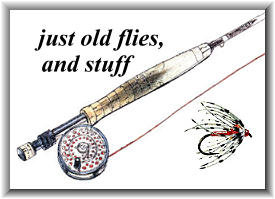Interesting how chance conversations can turn into something
substantial. One evening in the Anglers Hut
(the FAOL Chat Room) we were discussing remarkable flies.
The Hewitt Skater was mentioned. The Neversink Skater is one
in the same.
Old Rupe recalled seeing it in an old Outdoor Life magazine.
He offered to try and find it. It took some serious digging
at the library - and his memory was correct. The June, 1976
issue to be exact, written by Vince Marinaro. Rupe made
a couple of copies of the article, sent one to slicfoot and
one to Jim Birkholm.
Slic put some long hours in at the bench to get the tying sequence
down to a science and mailed the results, in steps, to Birkholm
who photographed the flies.
The publisher of this website got into the act too. A couple
of phone calls to Ed Scheff, editor of Outdoor Life
for permission to quote the instructions and how to fish the
fly. Ed was most happy to accommodate us. Ed did ask
if we would mention the
Outdoor Life website 'tho. Our pleasure!
The Neversink Skater is also known as a "Butterfly", and
has caught every manner of fish imaginable. It can be tied
very large, the size of a silver dollar, or as small as you feel
confident to tie. Fishing instructions follow the tying
instructions.
Tying Instructions:
1. "Choose two long-fibered stiff feathers from the
edge of a hackle neck (skater should have a diameter of at least
two inches); any color will do. Wax only one inch at the end of
tying thread to help anchor it to hook shank. Use weighted bobbin.
Tie one hackle onto hook, concave side up, as shown. Half-hitch.

2. Bend feather sharply toward eye. Wrap thread
in wide-open turns up to eye, and let it hang there.

3. Grasp tip of hackle with heavy hackle pliers,
and wind in wide-open turns over thread to eye. Let
it hang there.
4. Pinch neck of hook with nails of thumb and middle
finger, and gently push everything back to bend of hook.
5. Repeat procedure - open turns of thread and hackle,
and push back - until half an inch of feather is left. Tie off.
6. Fly should now look like this.

7. Tie in second hackle very close to tie-off of first hackle, concave
side up.
8. Bend feather up and repeat same open-wrap,
push-back procedure as with first hackle. Tie off.

9. Pinch hook at neck and at bend, and push everything together
firmly. Take fly out of vise, and push together some more in several
places around hook shank to even-up hackle around the perimeter.
10. Add drop of rod varnish - not lacquer on thread at head
and rear. The finished fly should look this this."

Fishing the Fly:
"Grease the leader as well as the fly. Use as short a cast as you
dare in order to have as little line on the water as possible. You will
be able to control the fly and do more tricks with it. In calm, smooth,
clear water long casts are sometimes necessary to avoid spooking
the fish. An 8 1/2 or nine-foot rod - if you can find one light enough
- is ideal for this fishing. In rough water, if you make a careful
approach it is often possible to keep all the line off the water.
You can use a tippet as heavy as 4X for trout and bass, but not lighter
than 5X. The strike to a skater is often violent, and you must resist the
impulse to strike back violently. Pause after the fish has taken, then
tighten up gently to set the hook.
For salmon fishing a six-pound-test leader is safe and still permits the
fly considerable freedom of movement.
The skater is a fragile fly. Its success depends greatly on keeping
it dry and shapely. Frequent blowing on the fly to restore its shape
and longer pauses between casts help to get rid of excess moisture.
. . .Alternatively, keep a few flies handy to exchange a wet one for
a dry one as needed.
The skater can be ruined if carried in the wrong kind of box.
Use a very shallow box with a felt liner in the bottom. The felt
will present the flies from sliding and piling up against one
another. Place the flies headdown on the felt. They may be
overlaped with one another without harm. Do not let the fiber tips
touch the sides of the box, or they will become bent and distorted.
The box should be thin enough so that the lid presses down slightly
on the flies to hold them in place.
The fly seems to work best on waters that have large
concentrations of fish, as in freshly stocked public or private
waters. Mr. Hewitt insisted that it is especially attractive to big
fish, in support of which he cited his own experiences and those
of John Atherton who is reputed to have caught, with the skater,
32 landlocked salmon on a single trip. As a specific imitation it is very
good for a hatch of big mayflies, as in the case of the eastern green
drake. I have never tried it but I think it would be successful
during the famed Limbata hatch in Michigan.
The only safe rule I can offer is that the fisherman should carry a
few at all times and try them when everything else fails - or
try them before everything else fails."~Vince Marinaro
|













